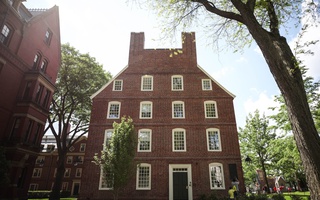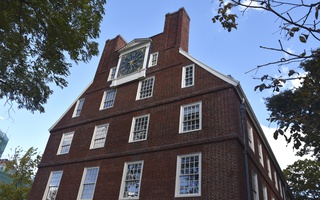{shortcode-72d1408e2780cd9ca1da1348772930a8916d5372}
Nearly 200 Harvard affiliates and supporters have signed onto an online petition calling for Harvard University to stop displaying, publishing, and selling the rights to the images of two enslaved people.
The daguerreotypes — believed to be some of the oldest extant photos of American slaves — depict an enslaved man named Renty and his daughter, Delia. Harvard biologist Louis Agassiz commissioned them in the 19th century to support his theory of white superiority.
Tamara K. Lanier, who says she is Renty’s great-great-great-granddaughter, filed suit against Harvard in March, alleging that the University unlawfully possesses and profits from the photos.
In her lawsuit, Lanier argues that University should the hand daguerreotypes over to her, which she alleges the school has refused to do. She also requests that Harvard cede any profits made from the photos and pay punitive damages to her, and that Harvard officials acknowledge the University “was complicit in perpetuating and justifying the institution of slavery.”
The images are currently housed in the Harvard Peabody Museum of Archaeology and Ethnology. The museum is named as a defendant in Lanier’s lawsuit.
The recent petition addresses the concerns raised in the lawsuit and urges Harvard to refrain from using the images for profit.
“Representatives of Harvard claim the present-day context in displaying them aims to highlight Africans’ humanity,” the petition reads. “However, the deep and true context for the slaves, for Renty and Delia, will never change.”
The petition also argues that the context of the photos is “frozen within the faces of each frame,” and that Renty and Delia should be laid to rest with their descendants.
“This is not an issue of law, this is an issue of persistent institutional and cultural violence perpetuated by Harvard University aimed toward African slaves,” the petition reads.
University spokesperson Jason A. Newton declined to comment on the petition.
Meredith N. McKinney, who is a degree candidate at Harvard Extension School and wrote the petition, was working on a project for one of her classes when she found the images of Renty and Delia and their connection to Harvard.
She said that she assumed the student body had developed a coalition to communicate students’ positions with regard to Harvard’s administrative decisions. She added that when realized there was a “lack of awareness” on campus, she decided to advocate for Lanier.
“My hope is to shine a bright light across campus and student networks on this issue to enable the student body to have a voice in this matter,” McKinney said.
McKinney said her intention is not to create an “us vs. them” environment when it comes to administrators and those who disagree with the school’s position on the images.
“The intention is to really spread awareness about the position Harvard is taking now,” she said. “I honestly believe the more students that understand this story, the more students would disagree with the way that Harvard is pursuing this ending.”
University President Lawrence S. Bacow said in an April interview that Harvard’s possession of the images was not illegal and that the Museum displays them in order to illustrate the slaves’ humanity.
“The way in which the University displayed the images of daguerreotypes, my understanding from President Faust — and you may wish to speak to her — was designed specifically to call people's attention to the fact that these were not chattel,” Bacow said at the time. “These were real people.”
Harvard’s role in the slave trade has become a topic of increasing campus debate in recent years.
Bacow and a representative from the island of Antigua and Barbuda are exploring educational partnerships after the country’s prime minister penned a letter to Bacow requesting reparations for the school’s ties to slavery.
In November, Bacow launched a new University-wide initiative to address and further research the school’s ties to slavery. The announcement of the initiative came approximately a month after Bacow publicly apologized for using the 13th Amendment to compare the University’s wealthy donors to slaves at an Alumni Affairs and Development staff meeting.
Before Bacow’s tenure, former University President Drew G. Faust, along with United States Representative John R. Lewis (D-Ga.), dedicated a plaque to four enslaved persons who lived and worked on campus in the 18th century.
Faust also accepted a Harvard Law School committee’s recommendation to remove the Law School’s seal, which included the Royall family crest, whose family owned slaves in the 18th century. Isaac Royall, Jr., a plantation owner and slave trader, helped endow Harvard’s first law professorship in 1815.
—Staff writer Michelle G. Kurilla can be reached at michelle.kurilla@thecrimson.com. Follow her on Twitter @MichelleKurilla.
Read more in University News
Public Health Faculty Urge University to Schedule Bargaining Sessions With UnionRecommended Articles
-
 Bacow Apologizes for Comparing Harvard Schools’ Relationships With Donors to Slavery
Bacow Apologizes for Comparing Harvard Schools’ Relationships With Donors to Slavery -
 Harvard Affiliates Call On Bacow to Support Prison Divestment Following Slavery Analogy
Harvard Affiliates Call On Bacow to Support Prison Divestment Following Slavery Analogy -
 Prime Minister of Antigua and Barbuda Demands Reparations for Harvard’s Association with Slavery in Letter to Bacow
Prime Minister of Antigua and Barbuda Demands Reparations for Harvard’s Association with Slavery in Letter to Bacow -
 Bacow Announces Initiative to Study Harvard's Ties to Slavery
Bacow Announces Initiative to Study Harvard's Ties to Slavery













